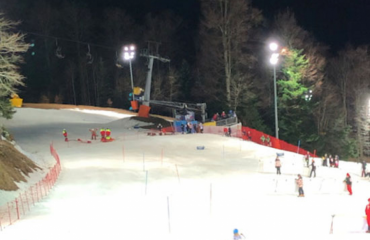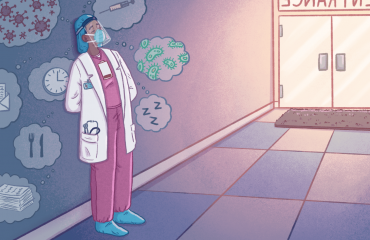Omicron in California: Bay Area health officials urge low-key New Year's Eve – San Francisco Chronicle
Nurse Shannon Baker makes her way to see a COVID-19 patient in a negative pressure room at El Camino Hospital in Mountain View, Calif.
California public health officials said the state would align with new CDC recommendations shortening quarantine times for people who test positive for COVID-19. Parts of the Bay Area have seen a near “vertical wall” jump in coronavirus cases over the past couple of weeks as the highly infectious omicron variant spreads widely — and those places that aren’t yet seeing surges should expect to soon. The omicron variant appears to be wildly contagious, but milder than previous variants. There are still many good reasons to avoid an infection.
Latest updates:
Bay Area counties not leaping to new guidelines: A day after the federal government and California adopted less restrictive isolation rules for people infected with the coronavirus, only Marin, Napa and San Mateo counties in the Bay Area have confirmed to The Chronicle that they are falling in line. The new guidelines shorten the isolation period for people whot test positive but have no symptoms, and the quarantine period for people who are exposed to the virus. San Francisco and Contra Costa counties said they are waiting for full details from the CDC. Dr. Nicholas Moss, health officer for Alameda County, said he’s reviewing it but worries that the focus on asymptomatic people could confuse the many people who have symptoms. Read more here.
Try to be “low key” for New Year’s celebration: Contra Costa County’s deputy public health officer, Ori Tzvieli said Tuesday that people should cut down on big New Year’s Eve plans to keep from getting and spreading COVID-19, and assess risk and transmissibility likelihood in making their plans. “This is maybe one of the New Years to take it easier, maybe stay at home,” he told a news briefing. That means reducing or canceling plans for large gatherings, he said, and taking rapid antigen tests to make sure you are negative before venturing out. “I recommend trying to be low key this New Year’s,” he said.
No New Year’s fireworks for S.F. The New Year’s Eve fireworks show on the Embarcadero in San Francisco is canceled this year, Mayor London Breed and public safety leaders announced Tuesday. They cited “the ongoing surge of COVID-19 cases” rapidly climbing in the city and California. “Enacting proactive measures that will best protect San Franciscans and essential front-line workers as the omicron variant is increasingly prevalent remains the city’s top priority,” said a statement from the officials. They said the city’s public safety agencies are “experiencing reduced staffing levels due to public health isolation and quarantine requirements brought on by COVID-19.” The fireworks show would need substantial deployment of police and other public safety personnel. Canceling it “not only reduces the risk of omicron exposure, but also minimizes impacts on critical safety systems like 9-1-1, allowing dispatchers to remain available to those in most critical need,” said Mary Ellen Carroll, executive director of emergency management.
Sonoma County urges boosters for work: Sonoma County employers should “immediately require all workers to get a booster dose” of the COVID-19 vaccine, if eligible, or get tested at least twice weekly, county health officials said Tuesday. The voluntary but strongly recommended guidelines are aimed at fighting the winter surge intensified by the omicron variant. “COVID-19 cases are increasing again in Sonoma County, but we can keep both our community and our economy healthy if employers require workers to get a booster shot as soon as they are eligible for one,” said county health officer Dr. Sundari Mase. Employers also should consider requiring unvaccinated and unboosted employees to wear surgical masks or respirators in indoor work settings, the county said. “Given how contagious the omicron variant is proving to be, cloth masks are just not as effective in stopping the spread of the virus,” said Mase.
Numbers confirm state’s winter surge: California numbers released Tuesday underscored the accounts of local health officials: that most if not all of the state is well into a new winter surge, fueled by the highly infectious omicron. Over four days a total of 13,454 new coronavirus cases were reported in the nine-county Bay Area and 86,027 for all of California. “We’re already seeing case numbers in excess of our worst days over the summer, and I think we’re going to keep right no climbing to the kinds of numbers we at least saw last winter,” said Dr. Nicholas Moss, the Alameda County health officer. About 4,400 people were hospitalized with COVID in California as of Monday — including 435 in the Bay Area — for a 37% increase from the start of the month.
Contra Costa County clamps down further on masking: Contra Costa County is now requiring that people wear face masks in all public indoor places including gyms, offices and workplaces, even if vaccinated, health officials announced Tuesday. The county is doing away with exceptions that had previously allowed uncovered faces for groups of 100 or fewer people where all were fully vaccinated. The new order is effective Wednesday. The county joins other Bay Area counties that already have taken this step in the face of the fast-spreading omicron variant. “We now know that anyone, regardless of vaccination status, can spread this variant to other people,” said Dr. Ori Tzvieli, county deputy health officer. “We anticipate the case rate and hospitalization numbers to increase over the coming weeks. To reduce spread, cases and hospitalizations, we all need to wear masks anytime we are in an indoor public setting.” The county’s average number of daily new COVID-19 cases has increased 149% over the last week and hospitalizations have risen 31%, officials said.
A rundown of the numbers as California cases skyrocket: California recorded enormous jumps in coronavirus cases over the Christmas holiday weekend, but hospitalizations remain manageable so far. Read this story for the latest figures and analysis from Chronicle health reporter Erin Allday.
Big leap in Bay Area’s daily new cases: Data reported Tuesday shows the Bay Area’s coronavirus case numbers jumping significantly just in the past few days as the omicron variant takes hold. The 7-day average of new daily cases was at 38 per 100,000 population on Tuesday, according to The Chronicle’s tracker based on numbers reported to the state. That’s up from just under 24 for the 7-day average reported on Friday, ahead of the holiday weekend.
Flight cancellations build: Continuing disruptions by weather and coronavirus-related staff shortages saw more than 1,000 flight cancellations in the U.S., and to and from the country, according to FlightAware, as many holiday travelers still were trying to get home. The COVID-19 surge driven by both the omicron and delta variants began to overwhelm airlines just before Christmas. Tuesday’s cancellations were down somewhat from Monday’s more than 1,400 flights canceled. At San Francisco International Airport, 3% of outbound flights and 5% of inbound flights had been canceled as of midday on Tuesday.
California positive test rate way up: The rate of positive COVID-19 tests lept significantly over the holiday weekend, California health officials reported Tuesday. The positivity rate — the percent of coronavirus tests that come back positive — averaged 9.7% over the past seven days, the state health department said. That’s far higher than the 3% reported just one week ago. And since both figures are weekly averages, the daily rate is undoubtedly much higher due to the omicron variant’s ubiquity.
NYC shifts school protocols: The nation’s largest school system will no longer quarantine entire classrooms exposed to Covid, and will instead use a ramped-up testing program to allow asymptomatic New York City students who test negative for the coronavirus to remain in school, the New York Times reports. Mayor Bill de Blasio announced the “Stay Safe, and Stay Open” policy on Tuesday, to take effect on Jan. 3, when the city’s nearly 1 million public school students return from holiday break as the omicron coronavirus rages.
U.S. lifts travel ban on African nations: President Biden on Tuesday revoked the travel restrictions that were placed last month on eight southern African nations, including South Africa, after the omicron variant erupted there. The repeal takes effect Friday. Administration officials had said that banning nearly all residents of those nations was needed to give the U.S. time to understand the variant and its spread. Tuesday’s proclamation noted evidence that vaccination against COVID-19 enables protection “against severe disease and hospitalization from the Omicron variant.” It also noted that omicron is now “prevalent” in the US.
CDC downgrades estimate of omicron prevalence in the U.S.: The omicron variant made up about 59% of all cases in the United States last week, according to new estimates released by the Centers for Disease Control and Prevention on Tuesday. The CDC also sharply downgraded its estimate for omicron prevalence the week before, from about 73% to 23%. Delta still makes up about 41% of all cases, the CDC said.
Mask up at indoor New Year bashes: In light of the fast-spreading omicron variant of the coronavirus, people should refrain from gathering indoors in groups of more than 10 unless they are wearing face masks, Santa Clara County’s health officer, Dr. Sara Cody, said Tuesday. “This New Year’s it’s not the time to go to a large gathering,” she said at a briefing. “The only exeption would be if you’re going to spend the entire gathering outdoors.” The county in strong recommendations on Tuesday also urged businesses to move operations outdoors again when possible, and called on employers to “immediately implement mandatory vaccination requirements for all personnel that require up-to-date vaccination as quickly as possible,” including booster shots. Places where people remove their masks indoors — namely restaurants and bars — should require patrons to show proof of vaccination and boosters for entry, the county urged.
Santa Clara County mandates staff boosters in high-risk settings: Santa Clara County on Tuesday announced it is requiring that eligible workers in high-risk settings get booster shots by Jan. 24, in addition to their COVID vaccinations, ahead of a similar state directive with a Feb. 1 deadline. That includes medical first responders and workers in hospitals and health care settings, nursing and long term care facilities, homeless shelters and jails and correctional facilities, county health officials said. The county says such workers must be up to date on their vaccines, meaning getting a booster as soon as they are eligible in terms of the time that’s passed since they received their vaccinations. People who have a religious exemption from vaccination will not be allowed to work in those settings and must be reassigned, the order stated. “Less than two weeks ago, we noted that the Omicron variant was about to bring a deluge of new COVID-19 cases to Santa Clara County. Unfortunately, that deluge is now here,” said Dr. Sara Cody, the county health officer.
Positive test rate rising fast: As Californians flock to get tests to learn if they are infected with the coronavirus, the rate of positive results is rising sharply. State health officials on Monday reported a 7-day average at 5.4%, a jump from 2.8% a week earlier. In both cases the Monday figures were likely underrepresentations because weekend numbers typically lag in getting recorded. For weeks before this past week, the positive test rate had been hovering between around 2.2% and 3%. A negative test result has become a sought-after barometer enabling people to engage with others in person.
Bay Area expected to surpass summer surge this week: Bay Area coronavirus cases, now increasingly driven by the highly infectious omicron variant, are quickly approaching the peak of the delta surge in early September. They likely will pass the summer peak this week, and may have already once cases not yet reported from the holiday weekend are recorded. The all-time peak was mid-January, with 4,700 cases a day in the Bay Area and 45,000 a day for the state. Ahead of the holiday, the Bay Area was reporting on average about 1,800 new cases a day — more than double from just the week before. California was reporting about 11,000 cases a day, an increase of about 90% from the week before.
A quarter of UCSF patients with symptoms are COVID-infected: As parts of the Bay Area see a near-vertical jump in coronavirus cases over the past couple of weeks, with surges expected in other places as well, hospitalizations have begun to climb too. But the hospitalizations still remain overall low and manageable, health officials said, likely due to the region’s overall high vaccination rates and the omicron variant causing milder illness. At UCSF, nearly 25% of patients admitted to the hospital with symptoms are testing positive for the coronavirus, compared to around 4% two weeks ago, said Dr. Robert Wachter, chief of medicine.
UCSF’s Wachter says omicron surge could last into March: Dr. Bob Wachter, chair of medicine at UCSF, tweeted that, given the average lengths of previous COVID-19 surges, the U.S. and Bay Area can expect to endure rising coronavirus infections for the next several months. “So if you are hunkering down with the current surge, it’s likely we’ll be coming out of it by March,” he said.
Navy says 25% of warship’s crew has COVID-19: U.S. defense officials said roughly 25% of the crew of the USS Milwaukee — or about 24 sailors — tested positive for COVID-19, enough to keep the ship waylaid at Naval Station Guantanamo Bay in Cuba. The crew was 100% immunized, Naval officials said.
Child hospitalizations spike in New York City: State officials in New York said Monday that the number of children hospitalized with COVID-19 nearly quintupled in a matter of weeks this month. New York City hospitals admitted 22 kids with COVID-19 in the week starting Dec. 5. By Dec. 19, that number had risen to 109.
Face masks and omicron — Should you upgrade from cloth to N95s? Double mask?: With a statewide indoor mask mandate underway and the rapid spread of the omicron variant, many people are wondering whether it’s time to double down on their masking habits — and upgrade their face coverings. So is now the time to buy a supply of N95 masks? Can double masking protect against the omicron variant? Here’s what Bay Area experts say you should know. Read the full story here.
UCSF doctor says one in 20 asymptomatic people may be infected as omicron spikes: Federal and state health officials on Monday shortened the time that people infected with or exposed to the coronavirus must isolate themselves from others, amid an enormous surge in cases nationwide, including unprecedented spikes across the Bay Area. Read the full story here.
California follows new CDC quarantine guidance: Public health officials said Monday that the state would follow recent recommendations from the Centers for Disease Control and Prevention shortening isolation and quarantine times for people who test positive for COVID-19. The new guidance shortens the isolation time from 10 days to five days for people infected with COVID-19 who are asymptomatic. After the five days, those individuals can leave isolation if they continue to mask for an additional five days. Read the full story here.
Omicron is everywhere and seems milder. Here’s why you still don’t want to get it: As omicron sweeps the Bay Area, we’re getting a better sense of it. It’s insanely contagious — everyone knows someone who has it — but also appears, for most people, to be milder than past variants. This combination of traits has raised an inevitable question: What’s the point in trying to avoid it? People are going to get it, and it probably won’t be too bad or land you in the hospital, especially for those who are vaccinated and boosted. So why not just give up and let it get you? Read the full story here.
Cruise ship outbreaks probed: The CDC said Monday it is investigating potential COVID-19 outbreaks of the virus on 68 cruise ships, Reutersreports. A handful of U.S. cruise ships have been denied entry into foreign ports due to reported outbreaks, according to ABC News. Last Thursday, Holland America’s Line ship the MS Koningsdam was turned away from Puerto Vallarta after 21 crew members tested positive for the virus.
More than 77% have at least one shot in U.S.: Across the nation, 77.3% of vaccine-eligible Americans, those 5 and older, now have received at least one shot, data from the Centers for Disease Control and Prevention shows. But the number fully vaccinated is just 65.6% of those eligible — just shy of 205 million people. And of the fully vaccinated adults, just over a third have received booster shots, which have become crucial over time as the effectiveness of a person’s initial vaccination wanes, the national data shows. Those under 18 are not yet eligible for boosters.
New isolation advice tied to wide omicron spread: CDC Director Rochelle Walensky said the country is about to see a lot of omicron cases, but shortening the recommended isolation time should not be a problem. “Not all of those cases are going to be severe. In fact many are going to be asymptomatic,” she told the Associated Press. The shortened isolation period guidance — that people without symptoms isolate for five days instead of the previously recommended 10 — is less stringent than loosened rules for health care workers that CDC announced last week.
Dominic Fracassa is an assistant metro editor overseeing breaking news and criminal justice in San Francisco. He previously covered San Francisco City Hall as a staff writer.



